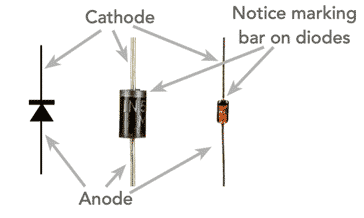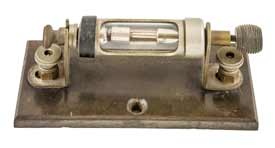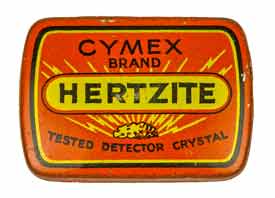Invention of the PN Junction Diode: Diode History
The invention of the PN junction diode was one of the first major practical developments in the history of semiconductor technology.
History of Semiconductor Diodes Includes:
PN junction diode invention
LED history
Zener diode invention
More semiconductor history
History of semiconductor technology development
Transistor history
Invention of the integrated circuit
The PN junction diode was the first semiconductor electronic components to be invented and then manufactured. The invention of the PN junction diode was one of the stepping stones for further semiconductor developments to be made.
However the PN diode invention itself relied on previous observations and electronic components that had come before it.
Although a large number of people were involved in its discovery, the the man who invented the PN junction diode is generally accepted to be Russel Ohl.
What is a PN junction diode
The PN junction diode is one of the most basic electronic components based around semiconductors. It is not only used as a discrete electronic component, but is contained within billions of integrated circuits.

The diodes can come in a variety of formats. The modern day discrete electronic components can be wire leaded and of a variety of sizes. The high current devices can even be bolted to heatsinks, while the smaller rectifier and signal diodes can be in much smaller packages.
Diodes can also come as surface mount devices, SMDs. These electronic components naturally tend to be the lower current diodes that are intended for printed circuit board mounting.
Note on the PN Junction Diode:
The PN junction diode is the most basic form of semiconductor device. Consisting of a single junction between P-type and N-type material it is able to act as a rectifier allowing current to pass in only one direction.
Read more about PN Junction Diode.
All of these diodes owe their existence to the developments that were undertaken over many years to bring us to the point in technology where we are today.
Early diode detectors
The earliest diodes were used within early wireless or radios. There were two types. One type was based upon thermionic valve / vacuum tube technology invented by Ambrose Fleming, and later developed into a three electrode triode or Audion by Lee de Forest.
The other type was based upon crystals of certain substances onto which a thin wire was placed.
Although the mechanism was not understood at the time, the materials we now know to be semiconductors and the wire created a point contact diode.The crystal detector, or as it later became known, the cat's whisker detector provided a much superior form of detection over the systems such as coherers and magnetic detectors that had previously been used. The output from the crystal detector was fed into a pair of headphones where the signal could be heard.
Like many inventions, a number of people started to report their use. One of the first reported uses of a crystal detector was by an Indian professor of Physics named Jagadis Chandra Bose who was at Presidency College in Calcutta. He demonstrated the use of a diode using galena (lead sulphide) crystals and a metal point contact. He filed a US patent for a point-contact semiconductor rectifier for detecting radio signals in 1901.
Then in 1906 a number of other patents were filed. One of the first in that year was filed by Ferdinand Braun in Germany who patented his detector on 18 February 1906. This crystal detector was based on psilomelan - a hydrated oxide of manganese.

Then on 21 February 1906, L W Austen filed a patent for a tellurium-silicon detector. Then a month later in March 1906, General H H C Dunwoody in the USA patented a carborundum detector. This was followed by Greenleaf W Pickard filing a patent in August of that year for a silicon metal rectifier. This was the culmination of around four years work for Pickard who said he had been working on crystal detectors since 1902.
The use of these diodes did not immediately take off. They were comparatively unreliable and the thermionic valve / vacuum tube technology was adopted for the professional uses of radio at the time. It was only in the 1920s and early 1930s where the value of a cheap detector came to the fore when public broadcasting started and affordable radio sets were needed for domestic use.

It was here that the low cost of the Cat's Whisker crystal detectors were used. That is until valve / vacuum technology became much cheaper and could be used for domestic radios. At this point the crystal detectors fell into disuse, but they were not totally forgotten.
Interestingly little was known about the way in which these crystal detectors worked, but it was observed that the detected signal could have a different polarity dependent upon the detector in use and aspects such as the type of crystal and wire in it.
Other rectifiers invented
It had long been known that selenium and even copper oxide were able to act as rectifiers.
The rectifying properties of selenium and a number of other materials we now know as semiconductors had been observed by Braun, Schuster and Siemens between 1874 and 1883. Further observations were made by Adams and day in 1876 and then C E Fitts in 1886, but actual devices were not made as the applications for them were not clear around these times.
The commercial manufacture of selenium rectifiers started in the 1930s where they were used in applications such as some radio sets and even automotive battery chargers etc.
Copper oxide was another material used for rectifiers, but their use was less widespread as selenium was able to operate with higher voltage levels.
The use of selenium rectifiers continued for many years. They were ultimately superseded by silicon devices in the early 1960s.
Later impetus for the PN junction diode invention
The interest in semiconductor diodes remain low for some years. However when tensions grew in Europe and Britain started to invest in Radar, and improve its performance to gain a much better idea of the location of enemy aircraft, ships and the like.
To improve the performance and definition, etc, it became necessary to increase the frequencies on which the radar sets operated.
Initially valves or vacuum tubes were used, but their performance fell as the frequencies increased and this became a limiting factor as frequencies entered the microwave region.
It had been seen that the point contact diodes or crystal detectors actually had a better frequency response than that of the valve / vacuum tube detectors, and this formed one of the motivators for further investigating semiconductor diode detectors.
Improving quality of silicon
Much work went on to investigate the way in which silicon could be purified to a much higher degree than had previously been required. In fact work was undertaken both in the US (primarily at Bell Labs) and also in Germany, although less is known about this work.
Previously there had been a lot of interchange of information about developments within the scientific community, but with the onset of war, the free passage of information ceased as both sides sought to gain the upper hand in the search for any new developments that might be of benefit.
In the USA J H Scaff and H C Theuerer at Bell managed to make silicon with a purity level an order of magnitude better than anything that had been achieved previously.
They also were able to make P-type and N-type semiconductor as well.
Work on developing PN junction diode
One researcher named Russell Shoemaker Ohl at Bell a had been investigating samples of different types of silicon in a reproducible manner. During this work he looked at many different samples of silicon that had been made.
It was during these investigations that the actual PN junction diode came about by accident. Ohl was working on a silicon crystal example that had a crack down the middle.
He tested the sample with an Ohmmeter to check the resistance and noted that it fell significantly when exposed to light. More current flowed when it was exposed to light.
It was known that selenium devices had similar properties and as a result it seemed that the cracked silicon sample behaved in a similar but unexpected manner.
Russell Ohl showed the device to his colleagues and they deduced that the crack was formed as the silicon froze in the crucible, and that different contaminants or impurities had separated into different regions of the sample. It was further deduced that one side of the sample was P-type material and the other N-type.
Further investigations showed that the PN junction produced a current when irradiated by light - a silicon solar cell which converted light into electricity had been invented. It was also shown that it had a much higher level of efficiency that the selenium cells which had previously exhibited this phenomenon.
The PN junction diode was not only a much better solar cell than had previously been seen, but also an excellent rectifier.
Ohl was awarded his US Patent in 1946 for the invention of the solar cell, and also a Patent for the invention of the PN junction diode. In this way Russell Ohl is the inventor of the PN junction diode.
Later PN junction diode developments
As the USA had awarded a number of very similar contracts to different organisations to ensure a major advancement in semiconductor technology, another group of scientists began work at Purdue University in the USA. Working under Karl Lark-Horovitz.
Their investigations focussed on understanding more about germanium and how it might be used in more effective radar detectors.
Their work investigated the fundamental properties of germanium, how it could be purified and thirdly how it could be used in more effective detectors.
Their work resulted in germanium diode detectors and gave germanium technology an early lead in the area of detectors.
For many years afterwards many germanium diodes were available. Companies like Mullard, for example, produced germanium diodes.

In addition to these diodes, many low cost simple point contact germanium diodes were manufactured. The semiconductor and wire contact could easily be seen in the glass envelope package.
In the years that followed, diode technology moved ahead significantly. No only were semiconductor diodes used as detectors in radar and radio systems, but power rectifiers were also developed to replace the power hungry vacuum tube / valve rectifiers and the less reliable selenium ones.
Today the work of Ohl as the inventor of the PN junction diode and the others who help prepare the way is almost forgotten, but the foundations they set in place are a cornerstone for modern electronics technology modern electronic components and electronic circuit designs.
 Written by Ian Poole .
Written by Ian Poole .
Experienced electronics engineer and author.
More History:
Radio history timeline
History of the radio
Ham radio history
Coherer
Crystal radio
Magnetic detector
Spark transmitter
Morse telegraph
Valve / tube history
PN junction diode invention
Transistor
Integrated circuit
Quartz crystals
Classic radios
Mobile telecoms history
Vintage mobile phones
Return to History menu . . .



